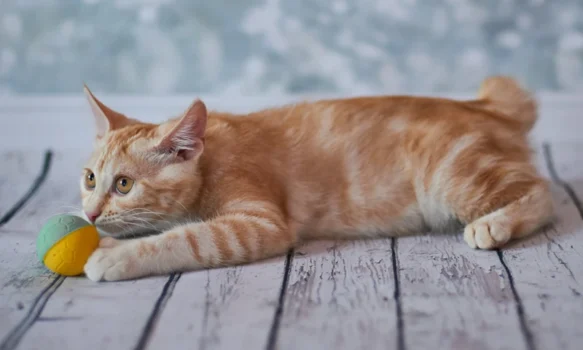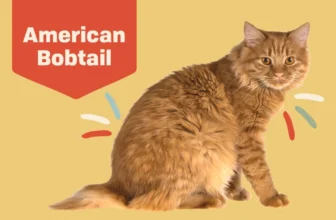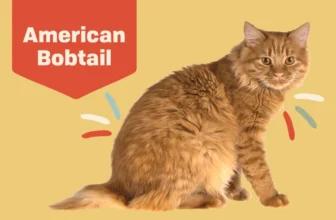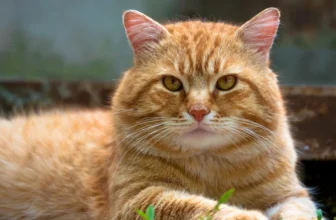As a cat owner, you may have noticed that your American Bobtail’s coat and color patterns are not always consistent. You may have even observed changes in their coat’s thickness, bald patches, or fading colors. These changes might have left you wondering about the reasons behind them and how to spot them in the future. In this article, we will explore the different coat types and color patterns of American Bobtail cats and discuss how to identify any changes in their appearance. We will also delve into potential causes of these changes so that you can take action and ensure your furry friend’s continued health and happiness.
Understanding Coat Types in American Bobtail
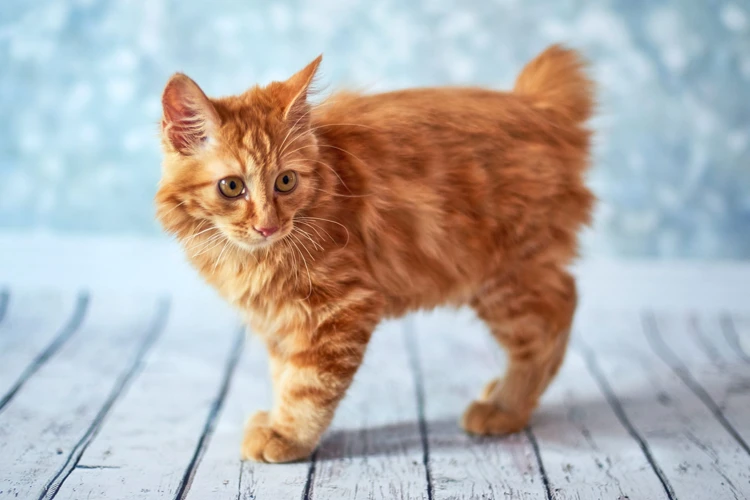
Understanding the coat types of the American Bobtail cat can help you better care for your feline friend. The American Bobtail is a breed known for its wild appearance and short bobbed tail, but did you know that their coats come in different lengths and textures? Knowing the characteristics of the different coat types and colors of American Bobtail cats can help you better identify potential health issues or changes in their appearance. Let’s explore the different coat types and textures of American Bobtail cats to help you become a more informed cat owner. For more information on coat colors, visit American Bobtail Cat Coat Colors.
Long Hair Vs. Short Hair
When it comes to American Bobtail cats, one of the first things you’ll notice is their unique and stunning coat. These cats can have either long or short hair, and both types require different levels of grooming.
Long Hair: American Bobtails with long hair have a slightly shaggy appearance and a plumed tail. Their fur tends to be softer and silkier than their short-haired counterparts. Long-haired American Bobtails require daily or biweekly grooming to prevent matting, tangles, and hairballs. Grooming also helps to spread natural oils throughout their coat, keeping it healthy and shiny.
Short Hair: American Bobtails with short hair have a dense, waterproof coat that lies close to their skin. Their coats are low maintenance, requiring only weekly brushing to remove loose hairs and distribute oils. Short-haired Bobtails’ coats are more resistant to matting and tangles, making them ideal for owners who prefer less grooming.
It’s important to note that coat length does not affect a Bobtail’s personality or behavior. Whether you prefer long or short-haired cats, these affectionate and intelligent felines are sure to steal your heart.
If you want to learn more about the genetics behind American Bobtail coat colors and patterns, check out our article on genetics and coat colors in American Bobtail cats. For tips on how to properly care for your Bobtail’s coat, head over to our guide on Bobtail cat coat care. And if you’re curious about different Bobtail coat types, be sure to read our in-depth article on Tabby Bobtail Cats.
Difference Between Single and Double Coat
One of the most important aspects to understand about American Bobtail cats is the difference between a single coat and double coat. A cat’s coat acts as a protective barrier that helps maintain its body temperature and protects its skin from the outside environment. American Bobtails can have either a single coat or a double coat, which can affect how they’re cared for and groomed.
A single coat has only one layer of fur, whereas a double coat consists of two layers – an outer layer of long guard hairs and an inner layer of short, dense undercoat. The undercoat acts as insulation, helping to keep the cat warm in colder temperatures, while the longer guard hairs help to repel dirt and water.
Here’s a table summarizing the key differences between single and double coat American Bobtail cats:
| Single Coat | Double Coat | |
|---|---|---|
| Hair Type | One layer of fur | Two layers of fur (long guard hairs + short undercoat) |
| Grooming Needs | Minimal grooming required | Regular brushing to prevent matting and shedding |
| Temperature Tolerance | Tend to tolerate warmer temperatures better | Tend to tolerate colder temperatures better |
| Shedding | May shed less than double-coated cats | Tend to shed more, especially during seasonal coat changes |
Knowing whether your American Bobtail has a single or double coat is important for proper grooming and temperature regulation. Single-coated cats may require less grooming than double-coated cats, but all cats need some level of grooming to keep their coat healthy and free of mats. You can learn more about American Bobtail coat types by reading our in-depth article.
Normal Coat and Color Patterns in American Bobtail Cats
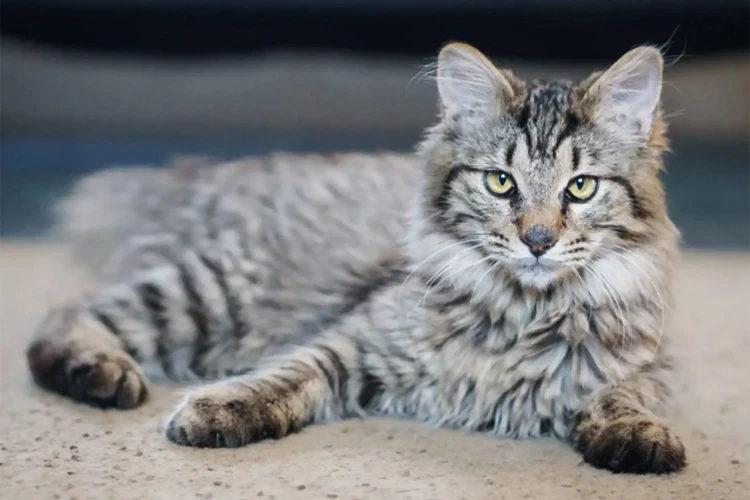
One of the most distinctive features of the American Bobtail cat breed is its coat. With a variety of patterns and colors, these cats are sure to capture your attention. Understanding the different coat types and color patterns that are normal for American Bobtail cats is important for identifying changes in your cat’s appearance. From the striking silver pattern to the classic tabby, each pattern has its own unique features. Let’s explore these patterns and colors in more detail. For more information on American Bobtail coat, visit /amer-bobtail-coat/.
Silver Pattern
The silver pattern is one of the coat patterns that are commonly found in American Bobtail cats. This pattern is also known as the “classic tabby” pattern. The silver pattern is characterized by bold black stripes that run vertically along the cat’s sides, and there are also circular patterns on the sides that may contain additional stripes. The background color of the coat is usually silver or light grey.
Distinctive features of the silver pattern include:
- The circular patterns on the sides of the cat’s body are known as “bull’s eye” patterns, as they resemble the shape of a bull’s eye
- The stripes on the cat’s forehead are shaped like an “M”
- There may be a white spot on the cat’s chin, chest, or stomach
It is important to note that not all American Bobtail cats with silver patterns will have the same coat markings. Each cat is unique and may have variations in the pattern, size, or color of their stripes.
How to distinguish silver pattern from other coat patterns:
- Classic pattern – the classic pattern also has vertical black stripes, but the background color is usually a warm tan or brown instead of silver.
- Mackerel pattern – the mackerel pattern has thin, vertical stripes that run parallel to each other down the cat’s sides, whereas the silver pattern has bold horizontal stripes and circular patterns.
- Spotted pattern – the spotted pattern has small or large circular spots on the coat, whereas the silver pattern has circular patterns that contain stripes.
The silver pattern is a popular coat pattern among American Bobtail cat owners, and it is important to keep an eye out for any changes in the coat and color of your cat. If you notice any thinning of the coat, color fading, appearance of bald patches, or any other unusual changes, it is best to seek the advice of a veterinarian to determine the cause and provide appropriate treatment.
Classic Pattern
The Classic Pattern is one of the most common coat patterns in American Bobtail cats. It is characterized by bold, swirling patterns that are often likened to the marbling of a steak. This pattern usually appears in shades of black and brown, but can also come in other colors like orange and grey.
To help you better understand the Classic Pattern, take a look at the following table:
| Feature | Description |
|---|---|
| Color | The base color of the coat is either black, brown, or orange. |
| Pattern | The swirls and patterns are thick and bold, resembling the marbling found in steaks. |
| Contrast | The patterns have a high contrast against the base color, creating a striking appearance. |
| Eyes and Nose | For cats with a Classic Pattern, their eyes are usually a shade of green or gold and their nose is black or brown. |
It is important to note that while the Classic Pattern is a common coat pattern in American Bobtail cats, there can be variations within the pattern. Some cats may have larger and bolder swirls, while others may have more subtle patterns. Additionally, the color of the coat can also vary within the Classic Pattern, ranging from light to dark shades of brown or black.
If you have an American Bobtail cat with a Classic Pattern, it is important to care for their coat properly. This can include regular grooming to prevent matting and tangling of the fur, as well as protecting them from excessive sun exposure to avoid color fading. If you notice any changes in the Classic Pattern, such as thinning or bald patches, it may indicate a health issue and a visit to the veterinarian may be necessary.
Mackerel Pattern
The Mackerel pattern is one of the most commonly seen coat patterns in American Bobtail cats. This pattern is characterized by vertical stripes that run down the length of the fur coat. The stripes are usually narrow and evenly spaced, and they can be seen on both the body and legs of the cat. The Mackerel pattern is popular among cat enthusiasts because it gives an impression of a tiger-like appearance.
Distinctive Features:
- Narrow vertical stripes
- Stripes evenly spaced
- Stripes run the length of the coat
- Stripes can be seen on both body and legs
The stripes on the American Bobtail cat should always be clearly defined and not blurred. The Mackerel pattern is usually seen in brown or black stripes, although they can also come in gray or blue colors. The background color of the coat with the Mackerel pattern is usually light colored, such as cream or white.
How to Spot Mackerel Pattern:
- Look for narrow, evenly spaced vertical stripes on the cat’s body and legs.
- Notice the stripes should not be blurry or broken.
- Check the background coat color – it should be light-colored.
If you’re interested in adopting or buying a cat with the Mackerel pattern, it’s important to find reputable breeders who have a good understanding of American Bobtail genetics. Keep in mind that just because a cat has the Mackerel pattern does not automatically mean it is purebred.
Maintaining Mackerel Pattern:
- Regular brushing to prevent matting of the fur
- Provide a balanced diet with necessary nutrients for healthy coat maintenance
- Regular veterinary checkups to prevent health issues that could affect the coat pattern
The Mackerel pattern is a beautiful and popular coat pattern in American Bobtail cats. With its distinctive narrow stripes running down the length of the coat, it gives a unique and striking tiger-like appearance. Keep in mind that any changes in color or quality of the coat may be an indication of health issues, so be sure to stay vigilant and check regularly.
Spotted Pattern
The spotted pattern is one of the four main coat patterns of American Bobtail cats. It features distinct spots on the coat that can vary in size and shape. The spotting can be irregular or well-defined, and the spots may be solid or hollow. Here are some notable characteristics of the spotted pattern:
- Color: The spotted pattern can occur in different colors, including brown, silver, and blue. The spots may be a different color than the base coat, creating a striking contrast.
- Density: The density of the spotting can vary as well. Some American Bobtail cats with the spotted pattern may have only a few spots, while others may be heavily speckled.
- Size and Shape: The size and shape of the spots can also differ. Some cats may have small, circular spots, while others may have larger, more irregularly shaped spots.
- Personality: In terms of personality, American Bobtail cats with the spotted pattern are known to be active, playful, and intelligent. They enjoy interacting with their owners and have a curious nature.
It’s important to note that while the spotted pattern is a desirable trait for many American Bobtail breeders and owners, it’s not the only coat pattern available. Cats with the classic, silver, and mackerel patterns are also highly sought after.
If you’re considering adopting an American Bobtail with the spotted pattern, it’s important to keep in mind that their coat may change over time and that they may experience coat and color changes due to various factors. It’s crucial to provide proper care and nutrition to maintain the cat’s coat health and to visit a veterinarian if you notice any significant coat or color changes.
Signs of Coat and Color Changes in American Bobtail Cats
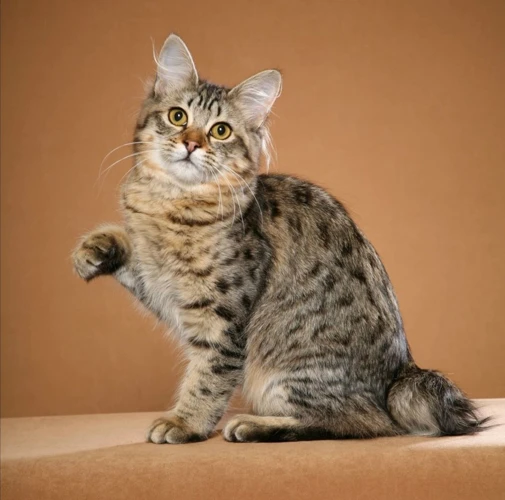
You may have noticed some changes in your American Bobtail cat’s coat and color that could be concerning. This is understandable since a cat’s coat and color are part of what makes them unique and beautiful. However, it is important to understand that changes to your cat’s coat and color can be a sign of an underlying issue. To help you identify these changes, we will highlight the signs of coat and color changes in American Bobtail cats. Knowing these signs can help you take the necessary steps to address any issues that may arise. So, let’s get started!
Thinning of Coat
One of the most common signs of coat changes in American Bobtail cats is the thinning of their coat. This can occur for a variety of reasons and can be caused by both environmental and health factors. If you notice your cat’s coat is thinning, it is important to take action to diagnose the underlying issue.
Here are some common reasons for thinning of coat in American Bobtail cats:
- Nutritional Deficiencies: A lack of certain vitamins and minerals can lead to hair loss and thinning of coat. If your cat is not getting the correct nutrition in their diet, their coat can suffer.
- Aging: As American Bobtail cats age, it is common for their coat to thin. This is a natural part of the aging process and can’t be prevented.
- Parasites: Parasites such as fleas or mites can damage the hair and cause it to fall out, leading to thinning of the coat. It is important to ensure your cat is protected from these parasites through preventative measures.
- Stress: Stressful situations, such as moving to a new home or the introduction of a new pet, can cause thinning of the coat.
- Medical Conditions: Medical conditions such as hyperthyroidism can lead to hair loss and thinning of the coat.
If you notice your American Bobtail cat’s coat is thinning, it is important to take them to the vet to help diagnose the underlying issue. The vet can run tests to determine if there is a medical condition at play, or if the issue is related to environmental factors or diet. Once the underlying issue is identified, the vet can recommend the appropriate treatment plan, which may include dietary changes or medication.
Noticing a thinning coat is a sign that something may be wrong with your American Bobtail cat’s health or living conditions. It is important to take swift action and seek assistance from a vet to help diagnose and treat the underlying issue.
Color Fading
Color fading is another notable coat change that you might spot in your American Bobtail Cats. This often happens due to a variety of reasons, such as aging or subjection to environmental stressors. The fading of coat color can happen gradually or abruptly and should be taken as a sign of concern. Here are some potential causes and preventive tips for color fading in American Bobtail Cats:
- Age: As your American Bobtail cat ages, the coat color may start to dissipate naturally. There is no real way to prevent age-related color fading, but you can help to slow down the process by providing adequate nourishment and keeping your cat away from external stressors.
- Sunburn: Just like humans, cats can experience sunburn, which can cause their coat to fade. If your cat spends extended periods in the sun, use protective measures such as keeping them indoors during peak sunlight hours, providing them with a shaded outdoor space, or using pet-safe sunblock.
- Nutritional Deficiencies: A cat’s health and coat color are closely linked, and nutritional deficiencies can lead to color fading. Ensure that your cat’s diet includes all the necessary nutrients, or switch to specially formulated cat food that meets their specific dietary needs.
- Stress: Environmental stressors such as loud noises, other pets or changes in their living environment can cause your American Bobtail Cat to suffer from anxiety or depression, leading to color fading amongst other symptoms. Ensure that your cat has a safe and comfortable environment, which minimizes potential stressors, and consider methods such as puzzle feeders or toys to keep their minds active.
If you notice color fading in your American Bobtail Cat, it’s important to address the issue promptly. Schedule an appointment with your veterinarian to rule out any underlying health problems. Changing your cat’s diet to include more nutritious foods, making environmental modifications, and easing sources of stress can help to prevent color fading and retain the vibrancy of their coat.
Appearance of Bald Patches
Appearance of Bald Patches in American Bobtail cats is a serious issue that should not be overlooked. Bald patches are areas on the skin where the fur has fallen off, leaving the skin exposed. These patches could occur in various sizes and shapes and are usually a sign of an underlying medical condition or skin disease.
Causes of Bald Patches in American Bobtail Cats
There are various reasons why bald patches can occur in American Bobtail cats. The most common cause could be due to parasites such as fleas, ticks or mites that can irritate the skin and cause the cat to scratch intensively leading to hair loss. Other possible causes include:
| Cause | Description |
|---|---|
| Allergies | Cats can develop allergies to certain foods or environmental factors, such as pollen or dust. Constant itching or scratching could result in hair loss and the formation of bald patches on the skin. |
| Fungal or Bacterial Infections | Fungal or bacterial infections can cause hair loss resulting in bald patches. These infections can spread quickly and cause more serious health conditions in your American Bobtail. |
| Stress | Stress can cause a range of health problems in cats, including hair loss. If your American Bobtail is experiencing stress, they may begin to over-groom themselves, resulting in hair loss and the appearance of bald patches. |
| Hormonal Imbalances | Imbalances in a cat’s hormones, such as those caused by hypothyroidism or Cushing’s disease, can cause hair loss in specific areas of the body, leading to the formation of bald patches. |
Treatment for Bald Patches in American Bobtail Cats
The treatment for bald patches in American Bobtail cats depends on the underlying cause. It is important to visit a veterinarian as soon as you notice signs of bald patches on your cat’s skin.
The vet will carry out a physical examination of the bald patches and may recommend additional tests, such as blood tests or skin biopsies if necessary. Once the underlying cause has been identified, the vet will prescribe an appropriate treatment that may range from topical ointments, medications, shampoos or dietary changes.
Preventing Bald Patches in American Bobtail Cats
Preventing bald patches in American Bobtail cats involves taking good care of their hygiene, diet and environment. Regular grooming such as brushing or combing your cat’s fur can reduce the risk of hair loss due to parasites, while a healthy and balanced diet can improve their overall health and prevent hormonal imbalances.
Noticing bald patches on your American Bobtail cat’s skin is a cause for concern, as it could be a sign of a serious underlying health issue or skin disease. Prompt veterinary attention is required to treat the root cause and prevent further progression of the condition.
Color Change Due to Health Issues
The color of your American Bobtail’s coat can change due to various health issues. Keep an eye out for these signs so you can take proper care of your furry friend. Here are some of the common health issues that can cause coat color changes in American Bobtails:
| Health Issue | Color Change |
|---|---|
| Hyperthyroidism | The coat color may turn dull and become lighter due to decreased production of melanin |
| Feline Leukemia Virus (FeLV) | The coat color may become lighter, and your American Bobtail may develop white or gray patches due to decreased production of pigment cells |
| Liver Disease | The coat color may become yellow or grayish due to a buildup of bilirubin in the bloodstream |
| Cushing’s Disease | The coat may become either lighter or darker due to an overproduction of cortisol which affects the production of melanin |
| Stress | The coat may become dull and lose its luster due to stress-induced hormonal changes that affect the production of melanin |
If you notice any of these color changes in your American Bobtail’s coat, it’s important to take them seriously and consult a veterinarian. Early detection and treatment of these health issues can prevent further damage and ensure your cat’s healthy and happy life.
Causes of Coat and Color Changes in American Bobtail Cats
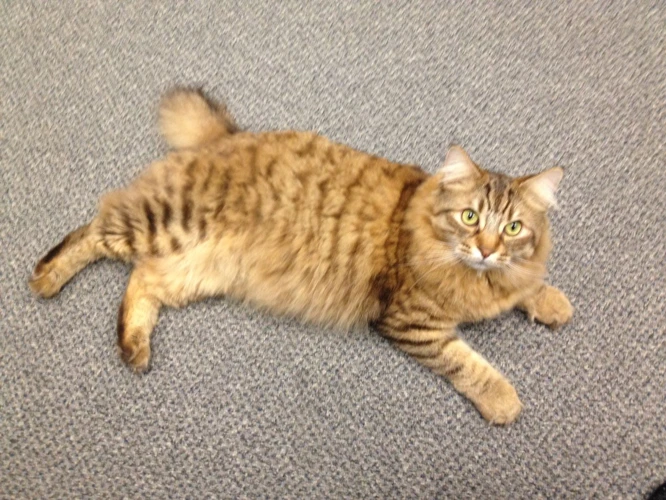
The coat and color of American Bobtail cats can change over time due to various factors. Understanding the causes behind these changes can help pet owners take better care of their beloved feline friends. In this section, we’ll explore the potential reasons for coat and color changes in American Bobtail cats. From hereditary factors to environmental influences, there are a variety of factors that may be responsible for changes to your cat’s coat and color. Let’s dive in and learn more!
Hereditary Factors
In American Bobtail cats, coat and color changes can be caused by various factors including hereditary factors. Genetic mutations can affect the development of coat type and color patterns in these feline breeds. Here are some hereditary factors that can lead to coat and color changes in American Bobtail cats:
- Feline Leukemia Virus: This virus can be passed down from the parent cats to their offspring and can cause coat changes as well as other health issues.
- Albinism: American Bobtails with albinism lack melanin, which gives them a white or pale coat color and pinkish eyes.
- Colorpoint: Colorpoint is a type of coat pattern caused by a genetic mutation that affects the production of melanin in certain areas of the body, resulting in darker coloration on the face, ears, paws, and tail. This mutation is responsible for breeds like Siamese and Himalayan cats.
- Congenital hypotrichosis: This hereditary condition results in the underdevelopment of hair follicles and can cause baldness, sparse coat, and skin problems.
- Polycystic kidney disease (PKD): PKD is an inherited disease that affects the kidneys, but it can also cause coat changes and skin problems in affected cats.
It is important to note that not all American Bobtails with the same genetic background will develop the same coat and color changes. The impact of these hereditary factors varies depending on other environmental and health factors.
Aging
As cats age, they undergo several physical changes, including changes in their coat and color patterns. These changes can be attributed to a variety of factors, including genetics, environment, and nutrition. Here are some of the ways aging affects the coat and color of American Bobtail cats:
| Change in Coat | Explanation |
|---|---|
| Thinning | As cats age, their hair follicles may decrease in size, leading to thinner fur. This is a normal part of the aging process and not a cause for concern, but excessive thinning may indicate an underlying health issue. |
| Coarse Texture | The hair of older cats may become coarse and dry due to decreased oil production from the sebaceous glands. This is also a normal part of aging, but providing regular grooming and a healthy diet can help improve the texture of their fur. |
| Color Fading | The coat of an aging American Bobtail cat may lose its vibrancy and the colors may look duller. This is because the melanocytes, which produce pigment in the hair follicles, decrease in number with age. |
It is important to note that these changes are a natural part of the aging process and not necessarily indicative of a health issue. However, it is always recommended to monitor any changes closely and consult with a veterinarian if necessary.
To help maintain a healthy coat and color in aging American Bobtail cats, it is recommended to provide them with a well-balanced diet rich in essential fatty acids and antioxidants. Regular grooming can also help to distribute natural oils throughout the coat and prevent matting or tangling. Finally, providing a comfortable and stress-free environment can help to ensure your cat avoids any unnecessary stress that could accelerate the aging process.
Sunburn
American Bobtail cats are social and active pets that love basking in the sun. However, a common problem that can arise from too much exposure to the sun is sunburn, which can have serious implications on their coat and skin. Sunburn in American Bobtail cats is characterized by reddening or darkening of the skin and hair loss, which can appear as bald patches.
Causes of Sunburn in American Bobtail Cats
The main cause of sunburn in American Bobtail cats is overexposure to the sun’s harmful ultraviolet (UV) rays. It is particularly common in cats with white or light-colored fur as they have less melanin, the pigment that protects the skin and hair from the sun. Cats that spend long hours basking in the sun, especially during peak hours when the sun is hottest, are at a higher risk of developing sunburn.
Preventing Sunburn in American Bobtail Cats
Prevention is key when it comes to sunburn. As a pet owner, there are measures you can take to protect your American Bobtail cat from sunburn. One effective way is to limit their sun exposure. This can be achieved by keeping them indoors during peak hours, particularly during the middle of the day when the sun is hottest.
Another way to protect your American Bobtail cat from sunburn is to apply sunscreen specifically formulated for cats. Human sunscreen contains chemicals that can be toxic to cats, so it is important to use a cat-specific sunscreen. Before applying sunscreen, it is recommended to consult your veterinarian to ensure it is safe for your feline friend.
Treatment for Sunburn in American Bobtail Cats
If your American Bobtail cat has already developed sunburn, it is crucial to seek veterinary care immediately. Treatment for sunburn typically involves topical applications of medicated creams or ointments to reduce inflammation and promote healing. Your veterinarian may also prescribe pain medication to alleviate discomfort and prevent the development of secondary infections.
Conclusion
Sunburn is a serious condition that can adversely affect the health of your American Bobtail cat. It is important to take preventive measures such as limiting their sun exposure and using sunscreens to protect their skin from the sun’s harmful effects. If your cat has already developed sunburn, seek veterinary help immediately to prevent further complications.
Nutritional Deficiencies
Nutritional deficiencies can also lead to coat and color changes in American Bobtail cats. A lack of essential nutrients in their diet can cause a dull or faded coat, bald patches, and even a change in coat color. Here are some common nutritional deficiencies that can affect your cat’s coat:
- Protein Deficiency: Protein is essential for maintaining a healthy coat. A lack of protein in a cat’s diet can lead to dry, brittle hair, and even hair loss. Make sure your cat’s diet includes high-quality protein sources like meat, fish, and eggs.
- Vitamin Deficiency: Vitamins play a crucial role in maintaining the health of a cat’s coat. Vitamin A, in particular, is important for the growth and maintenance of hair. A lack of vitamin A can cause a dry, flaky coat or even hair loss. Other important vitamins for a healthy coat include vitamin E and B-complex vitamins. Make sure your cat’s diet includes a balanced blend of vitamins and minerals.
- Fatty Acid Deficiency: Fatty acids are essential for maintaining healthy skin and coat. Omega-3 and omega-6 fatty acids, in particular, are important for reducing inflammation and promoting healthy hair growth. A lack of essential fatty acids in a cat’s diet can cause a dry, dull coat and even skin problems like dermatitis. Make sure your cat’s diet includes fatty acid-rich foods like fish and flaxseed oil.
It’s important to provide your cat with a balanced and nutritious diet to prevent nutritional deficiencies and maintain a healthy coat. If you notice changes in your cat’s coat or color, it’s important to consult with your vet to rule out any underlying health issues and make any necessary changes to their diet.
Environmental Factors
Environmental factors can play a significant role in causing coat and color changes in American Bobtail cats. Some common environmental factors that can lead to these changes are:
| Factor | Description |
|---|---|
| Seasonal Changes | Changes in temperature and humidity can impact your cat’s coat. During winter, your cat’s coat may become thicker and longer to keep them warm. In contrast, during summer, their coat may become shorter to keep them cool. |
| Exposure to Chemicals | Harsh chemicals, such as cleaning agents and pesticides, can be harmful to your cat’s skin and coat. These chemicals can cause skin irritation, resulting in fur loss and color change. |
| Excessive Grooming | While grooming is crucial for cats, excessive grooming can be damaging to their coat. Over-grooming can result in hair loss or thinning and may change the texture of the fur. |
| Stress | Stress can take a toll on your cat’s health, and it can show in their coat. Some cats may experience fur loss or discoloration due to stress-induced grooming habits or hormonal changes. |
| Exposure to Sunlight | Overexposure to sunlight can lead to sunburn and oxidative stress, causing fur to become dry, brittle, and discolored. |
It’s essential to be mindful of your cat’s environment and limit their exposure to harmful chemicals, excessive heat, or stressors whenever possible. If you suspect that your cat’s coat or color change may be due to environmental factors, make sure to consult with a veterinarian to rule out any underlying health issues. By paying attention to your cat’s behavior and appearance, you can take the necessary steps to ensure their coat remains healthy and vibrant.
What to do if you Notice Coat or Color Changes?
Noticing changes in your American Bobtail cat’s coat or color can be a cause for concern. While some variations may be a natural occurrence, it’s important to monitor any significant changes and take action if necessary. You may be wondering what steps you should take if you do notice such changes. With a little bit of care and attention, you can help your feline friend maintain a healthy coat and prevent any further color changes. In this section, we will discuss some tips on what you can do to help.
Visit a Vet
If you observe any unusual coat or color changes in your American Bobtail cat, taking them to a veterinarian is essential. Apart from proper diagnosis, early intervention can prevent more extensive damages to your cat’s skin and coat. A vet will examine your cat’s skin and ask about its diet, lifestyle, and environment. They will consider several factors, such as breed, age, stress levels, and nutritional deficiencies, to determine the underlying cause of the coat and color changes.
The veterinarian might also run some diagnostic tests, such as a blood panel, urine analysis, or skin biopsy, to rule out any underlying health problems. Depending on the diagnosis, the vet may prescribe topical treatments, dietary supplements or recommend a change in diet or environment. If the coat or color changes are caused by an infection or infestation, then the vet might prescribe antibiotics or anti-parasitic medicines.
Table: Some common tests recommended by the veterinarian to diagnose skin and coat changes in cats
| Diagnostic Test | Description |
|---|---|
| Skin cytology | Examination of skin cells under a microscope to detect skin diseases such as bacterial or fungal infections, allergy, or cancer |
| Biopsy | A small skin sample is taken and examined microscopically to evaluate and diagnose any skin condition or disease |
| Skin scrapings | Test to diagnose skin mites or external parasites |
| Blood test | Tests to analyze liver, kidney, and thyroid function to detect underlying health problems that may lead to skin and coat changes |
Visit a vet if you observe any unusual coat or color changes in your American Bobtail. Early diagnosis and intervention can prevent the progression of any underlying disease or condition, ensuring that your cat remains healthy and happy.
Change in Diet and Environment
One of the causes of coat and color changes in American Bobtail cats is a change in diet and environment. A cat’s diet plays a crucial role in keeping its fur and skin healthy. A diet that lacks essential nutrients can lead to hair loss, dull coat, and dry skin. It is important to ensure that your American Bobtail cat is getting a proper and balanced diet. A diet that contains sufficient amounts of protein, vitamins, and minerals can help to maintain the coat’s texture, color, and luster.
In addition to diet, the environment can also play a significant role in the health of your cat’s coat. A dirty and dusty environment can cause skin irritation, which can lead to scratching and fur loss. It’s important to keep your American Bobtail’s environment clean and free from dust, dander, and other irritants that can harm their coat. Access to fresh water is also essential as it helps to keep the coat hydrated and shiny.
To ensure that your American Bobtail’s coat remains healthy, you need to make a few dietary and environmental changes. Below is a table highlighting some dietary and environmental changes that can help to maintain the coat and color of your American Bobtail cat:
| Dietary Changes | Environmental Changes |
|---|---|
| Provide your cat with high-quality cat food that contains essential nutrients like protein, vitamins (A, B, C, and E), and minerals such as zinc and copper | Clean your cat’s litter box and environment regularly to prevent dust and dirt from accumulating which can cause irritation |
| Give your cat omega-3 and omega-6 fatty acids which help to maintain the shine and luster of its coat | Invest in a good quality air purifier that can help to remove harmful airborne particles such as dust and allergens from your cat’s environment |
| Avoid giving your cat table scraps and human food which can be harmful to its health | Providing a comfortable cat bed can help to reduce stress and promote relaxation, which can lead to a healthier coat |
By making these dietary and environmental changes, you can help to ensure that your American Bobtail cat’s coat and color remains healthy and vibrant. However, if you notice any persistent changes in your cat’s coat or color, it’s important to seek veterinary advice as some underlying health conditions may need to be addressed.
Conclusion
After reading this detailed guide on spotting coat and color changes in American Bobtail cats, you should have a better understanding of the different coat types and color patterns that are considered normal. It is important for every cat owner to monitor their pet’s coat and color changes as they can signify underlying health issues that can seriously affect their well-being.
If you start noticing any thinning, color fading, or bald patches, it is crucial to take action immediately. This can include scheduling a visit to a veterinarian who can help you identify the underlying cause or changing their diet and environment if you suspect environmental factors are the culprits.
Hereditary factors, aging, sunburn, nutritional deficiencies, and environmental factors can all contribute to coat and color changes in American Bobtail cats. As a responsible cat owner, it is your duty to keep an eye on any changes so that you can take prompt steps to maintain your furry friend’s overall health and well-being.
Remember, the coat of a cat is a vital part of their appearance and serves important functions, such as insulation from heat and cold, protection against injury, and camouflage during hunting. By maintaining a healthy coat and preventing any negative changes, you can ensure that your American Bobtail cat remains happy and healthy for years to come.
Frequently Asked Questions
What is the average lifespan of an American Bobtail cat?
The average lifespan of an American Bobtail cat is around 13-15 years.
Is it true that American Bobtail cats are prone to specific health issues?
While American Bobtail cats are generally healthy, they may be prone to certain health issues such as hip dysplasia, kidney disease, and heart disease.
Can American Bobtail cats be indoor-only pets?
Yes, American Bobtail cats can be happy indoor-only pets as long as they have plenty of stimulation and play opportunities.
Do American Bobtail cats shed a lot?
It depends on the type of coat they have. American Bobtail cats with longer hair tend to shed more compared to those with shorter hair.
Are American Bobtail cats lap cats?
Yes, American Bobtail cats can make great lap cats and enjoy cuddling with their owners.
How often should I groom my American Bobtail cat?
American Bobtail cats should be groomed at least once a week to prevent matting and tangles in their fur.
Do American Bobtail cats like water?
Some American Bobtail cats may enjoy playing with water, but not all cats of this breed like water.
Are American Bobtail cats good with children?
Yes, American Bobtail cats can be great with children as they are known to be patient and playful.
Can American Bobtail cats be trained to do tricks?
Yes, American Bobtail cats can be trained to do tricks as they are intelligent and eager to please their owners.
Can American Bobtail cats live with other pets?
Yes, American Bobtail cats can live peacefully with other pets as long as they are introduced properly and socialized from a young age.

